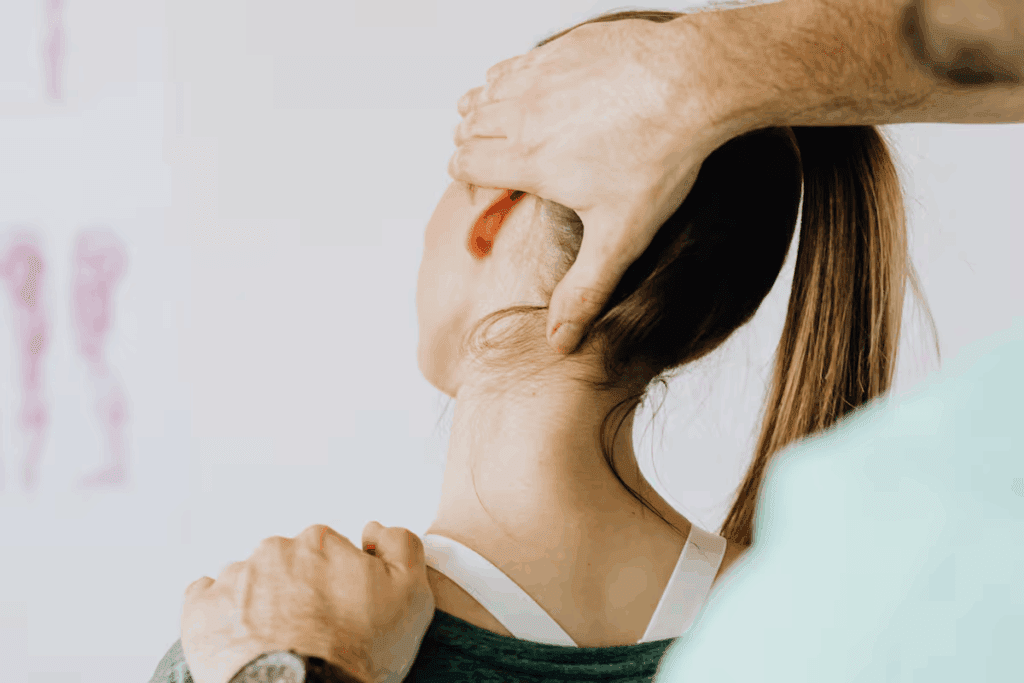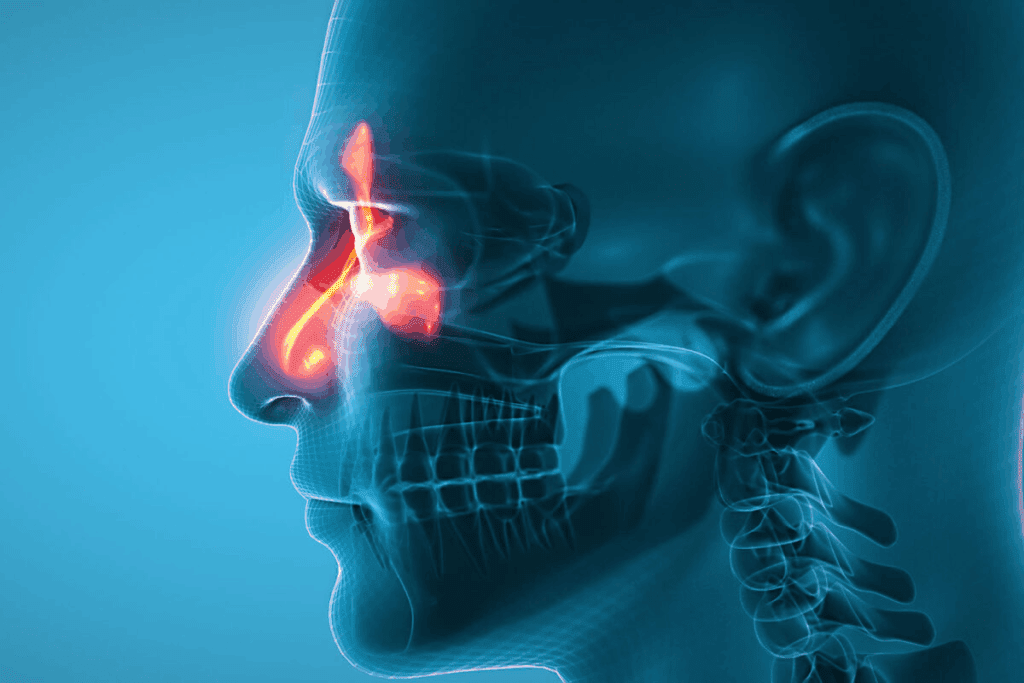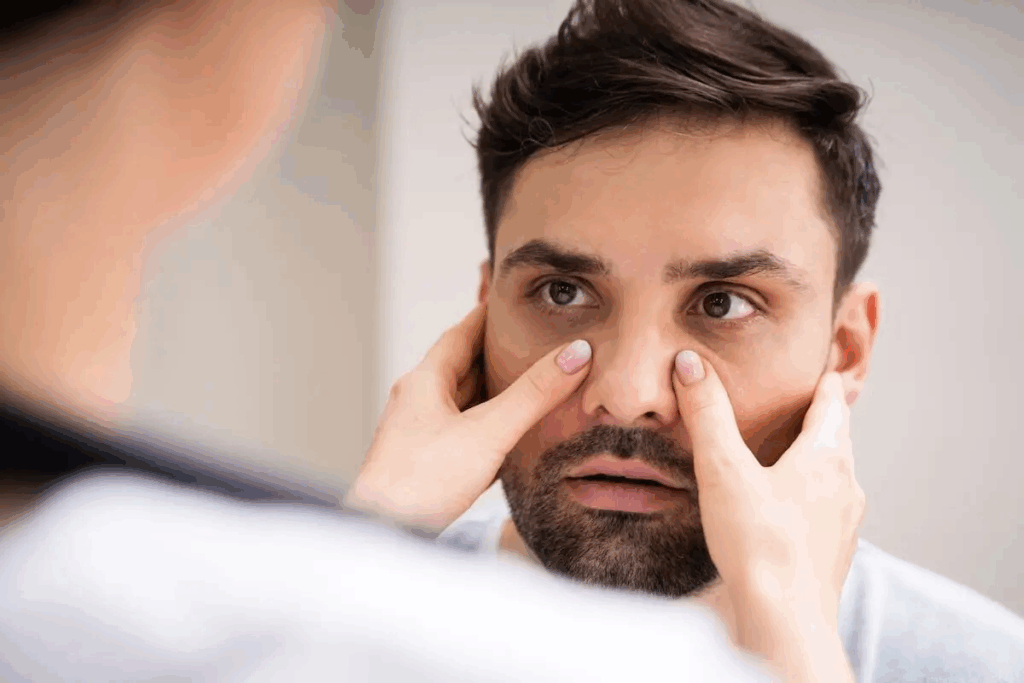
Sinus infections, or sinusitis, affect nearly 29 million adults in the United States each year. Studies show that about 84% of people with sinus headaches also have neck pain. Can sinus cause neck pain? Learn how the strain from persistent coughing and headache can lead to neck stiffness.
At Liv Hospital, we know that sinus congestion can cause discomfort. This discomfort can spread to the neck and shoulders. Our team focuses on diagnosing and treating neck pain caused by sinus infections.

Sinus problems and neck pain are linked in a complex way. When sinuses get inflamed or infected, it can cause more than just stuffy noses. Symptoms like facial pressure, headaches, and neck pain can occur.
Many people with sinusitis also experience neck pain or stiffness. This is because sinus infections can send pain signals to the neck through shared nerves.
Let’s look at some statistics to understand how common neck pain is in sinus infection patients:
Study | Sample Size | Percentage Reporting Neck Pain |
Smith et al., 2020 | 500 | 42% |
Johnson et al., 2019 | 300 | 35% |
Williams et al., 2018 | 800 | 48% |
Sinus issues can impact the neck in several ways. Referred pain is a big factor, where pain from the sinuses feels like it’s coming from the neck. Inflammation and pressure from sinus infections can also irritate nearby tissues and nerves, causing neck discomfort.
People with sinus infections might also change how they sit or stand to feel better. This can lead to neck strain and pain.
It’s important to understand these connections for diagnosis and treatment. By treating the sinus infection, doctors can also help with neck pain, improving patient care.

To understand how sinus infections and neck pain are connected, we need to know about sinus anatomy and function. The sinuses are air-filled spaces inside the skull. They are near the base and upper neck. They play a key role in our breathing health.
The human skull has four pairs of sinuses: frontal, maxillary, ethmoid, and sphenoid. Each pair is in a different spot and does a different job. Together, they make mucus to moisten the air we breathe and filter out dust and other stuff.
In good health, the sinuses make a small amount of mucus that drains into the nasal cavity. But when sinuses get infected or inflamed, this drainage can get blocked. This leads to mucus buildup and pressure. This condition, called sinusitis, can cause face and neck pain, pressure, and stiffness.
It’s important to know the difference between normal sinus function and infected sinuses. Infected sinuses can cause serious problems if not treated. So, if symptoms don’t go away, it’s key to see a doctor.
Sinus infections, or sinusitis, can start in many ways. They often involve a mix of factors. Knowing these factors helps in preventing and treating them.
Many things can lead to sinusitis. Viral infections are a big cause, causing acute sinusitis. Bacterial infections can also start sinusitis, sometimes after a virus. Allergies play a big role too, causing inflammation and more mucus, which can block the sinuses.
Having a deviated septum or nasal polyps can also lead to sinus infections. These blockages stop the sinuses from draining properly. Pollutants and tobacco smoke can also irritate the sinuses, raising the risk of infection.
Sinus infections fall into two types: acute and chronic. Acute sinusitis starts suddenly and lasts less than four weeks. It’s often from a virus and can cause nasal blockage, facial pain, and headaches.
Chronic sinusitis lasts more than 12 weeks. It’s caused by ongoing inflammation or infection. It can be due to allergies, anatomical issues, or immune problems. Chronic sinusitis can really affect your life, causing constant nasal blockage, loss of smell, and facial pain.
“Chronic sinusitis can be a challenging condition to manage, requiring a thorough treatment plan that tackles the root causes and symptoms.”
— Expert in Otolaryngology
It’s key to know the difference between acute and chronic sinusitis for effective treatment. Acute sinusitis might need little treatment, but chronic sinusitis needs a more detailed approach.
Looking into how sinus infections and neck pain are connected shows a mix of factors. These include referred pain, inflammation, and changes in how we stand. We’ll dive into these to see how sinusitis can cause neck pain.
One key way sinus infections cause neck pain is through referred pain pathways. Referred pain is when pain feels in a place other than where it’s happening. For sinusitis, pain from the sinuses can spread to the neck.
The sinuses are connected to nerves that also reach the neck. When sinuses get inflamed, they can send pain signals to the neck. This makes it hard to find where the pain is coming from.
Inflammation and pressure in the sinuses also play a part in neck pain from sinus infections. When sinuses get infected, they fill with fluid and pus. This increases pressure and causes pain that spreads to the neck.
Also, the inflammation from sinusitis can make nerves more sensitive. This can make pain in the neck worse for people with sinus infections.
People with sinus infections often change how they stand to feel better. They might tilt their head forward or to the side. While this might help a bit, it can also strain neck muscles and cause pain.
Also, sinusitis can make people breathe through their mouth more. This can change how they hold their head and neck. Over time, this can lead to neck pain.
Understanding these mechanisms helps us see how sinus infections and neck pain are connected. This knowledge is key for finding good treatments that help both the sinus infection and the neck pain.
Sphenoid sinusitis affects neck comfort more than you might think. It’s located deep in the skull, near important structures. When these sinuses get infected or inflamed, it can cause neck pain.
The sphenoid sinuses are in a special spot, near the base of the skull and the upper neck. This close relationship is key to understanding why sphenoid sinusitis can hurt the neck. The inflammation from sphenoid sinusitis can spread to the neck because of the nerves and blood vessels there.
Sphenoid infections often hurt the neck because they’re deep in the skull, near the neck. When these sinuses get infected, the swelling can reach nearby areas. This leads to pain in the neck. The way pain signals are sent from the sinuses to the neck is a big part of this problem.
It’s important to understand how sphenoid sinusitis and neck pain are connected. By knowing how sphenoid sinus infections work, doctors can help treat neck pain better. This improves how patients feel and do.
When sinuses don’t drain right, it can cause post-nasal drip. This drip irritates the neck. It happens when too much mucus from the sinuses flows down the back of the throat.
The constant mucus drip can make the throat and neck sore. People might change how they sit or sleep to feel better. This can put extra strain on the neck muscles.
They might lean forward or hunch over to avoid the drip. This can make neck pain worse.
When we’re sick, we might use more pillows to keep mucus out of our throats. This can also strain the neck muscles. The combination of post-nasal drip and altered posture can cause a lot of neck pain.
Post-nasal drip can be really annoying at night. When we lie down, mucus can build up in our throats. This makes the drip feel worse.
This can make it hard to sleep well and lead to neck stiffness in the morning. Waking up, people might feel stiff or sore in their necks.
To get rid of morning neck stiffness, we need to fix the sinus problem. By managing sinus drainage, we can reduce post-nasal drip. This helps lessen neck pain and stiffness in the morning.
It’s important to tell if neck pain comes from sinus problems or something else. Sinus infections can make your neck hurt. But, it’s key to know if the pain is from the sinuses or another problem.
Neck pain can mean many things, not just sinus infections. Cervical spine issues can also cause a lot of neck pain. So, it’s important to know the difference between pain from sinuses and other causes.
Cervical spine problems, like herniated discs, can feel like sinus pain. But, there are big differences. Pain from the spine might feel like numbness in your arms, sharp pain down your neck, or stiffness that doesn’t go away after sinus symptoms do.
On the other hand, pain from sinuses usually comes with other symptoms like a stuffy nose, facial pressure, or headaches. If your neck pain keeps going or gets worse without these symptoms, it might be from your spine.
“Accurate diagnosis is key to effective treatment. If you’re experiencing persistent or severe neck pain, it’s essential to consult a healthcare professional to determine the underlying cause.”
It’s also important to know when neck pain isn’t from sinuses. For example, if you have neck pain without other sinus symptoms, it might be from something else. Common reasons include poor posture, muscle strain, or underlying cervical spine conditions.
Knowing these signs can help you get the right medical care. If you’re not sure why your neck hurts, seeing a doctor is the best thing to do.
When sinus infections cause neck pain, finding the right diagnosis is key. Sinus infections can be very uncomfortable. Neck pain adds to the challenge, making it important to find the cause.
Diagnosing sinus infections with neck symptoms starts with a detailed medical check-up. We first take a thorough medical history. This helps us understand if past sinus infections or allergies might be causing the current issue.
Then, a physical exam is done. We look for signs like nasal congestion, facial tenderness, and postnasal drip. We also check the neck for stiffness, pain, and swollen lymph nodes.
Key Components of Medical Evaluation:
To confirm the diagnosis, we use imaging and diagnostic tests. These include:
Diagnostic Test | Purpose |
CT Scan of Sinuses | To visualize the sinuses and assess the extent of infection or inflammation |
X-ray of Sinuses | To evaluate the sinuses for signs of infection or other abnormalities |
Nasal Endoscopy | To directly visualize the nasal passages and sinuses |
The American Academy of Otolaryngology says, “Imaging studies are often necessary to confirm the diagnosis of sinusitis and to rule out other conditions that may be causing symptoms.”
“Imaging studies are often necessary to confirm the diagnosis of sinusitis and to rule out other conditions that may be causing symptoms.”
American Academy of Otolaryngology
We also consider other tests, like allergy testing. This helps us find any allergies that might be causing sinusitis.
By combining the results of the medical evaluation and diagnostic tests, we can accurately diagnose sinus infections with neck symptoms. Then, we can create an effective treatment plan.
When sinus infections cause neck pain, treating both the infection and the pain is key. A mix of medical help and self-care is needed.
To treat sinus-related neck pain, start by tackling the infection. This might include:
Along with medical treatments, home remedies can help with sinus and neck pain:
Practicing good sleep habits, like sleeping with your head elevated, can also help.
For serious sinus infections, medical treatments are needed. This can include:
Antibiotics are usually for bacterial infections that are severe or don’t go away. It’s important to follow your doctor’s advice on antibiotics to treat the infection well and avoid antibiotic resistance.
By using these treatments together, people can manage sinus-related neck pain and improve their life quality.
It’s important to know how sinus infections and neck pain are linked. Also, knowing when to see a doctor is key. Sometimes, home remedies can help, but other times, you need medical help to avoid serious problems.
Some symptoms mean you should see a doctor right away. Medical Expert, president of Teladoc Health Medical Group, says, “A bacterial infection could be serious if you’re having a severe or constant headache, neck pain or stiffness, extreme sleepiness or a change in mental state.” These signs point to a bacterial infection that might need antibiotics.
Other signs that mean you should see a doctor include:
At your doctor’s office, you’ll get a thorough check-up. The doctor will first ask about your symptoms, how long you’ve had them, and any treatments you’ve tried. Then, they’ll do a physical exam, focusing on your sinuses, neck, and overall health.
Based on what they find, your doctor might suggest more tests, like:
After figuring out what’s causing your symptoms, your doctor will create a treatment plan just for you. This might include medicines, lifestyle changes, or other treatments to help with both your sinus infection and neck pain.
It’s key to know how sinus infections and neck pain are linked. We’ve seen how sinus issues can cause neck pain. Fixing the sinus problem is the first step to easing neck pain.
For neck pain tied to sinus pressure, there are gentle fixes. Try a warm compress on your face and neck. Drinking plenty of water, clearing your sinuses, and using a supportive pillow can help too. Also, avoid sleeping in a way that strains your neck.
By tackling sinus pain and using these simple tips, you can ease neck pain. It’s vital to grasp the link between sinus and neck pain to manage symptoms well.
Yes, sinus infections can lead to neck pain and stiffness. This happens through referred pain pathways, inflammation, and how we adjust our posture.
Sphenoid sinusitis is an infection of the sphenoid sinuses. These sinuses are in a special spot that can cause neck pain when they get infected.
Post-nasal drip can irritate the neck muscles. This irritation can cause discomfort and stiffness, often felt in the morning.
Sinusitis can be caused by viruses or bacteria, allergies, or problems with the shape of the sinuses.
Sinus-related neck pain often comes with other symptoms like congestion and facial pressure. Neck pain from other causes might be related to the spine.
Doctors use medical evaluation, CT scans, and other tests to confirm a sinus infection with neck symptoms.
Treatment includes treating the sinus infection, using home remedies, and medical treatments like antibiotics when needed.
Yes, some sinus infections can be treated at home. You can use nasal decongestants, saline sprays, and pain relievers.
See a doctor if your symptoms are severe, don’t go away, or if you have trouble breathing. Also, if your symptoms get worse over time.
At a doctor’s visit, you’ll get a medical check-up. You might have imaging tests to find out what’s causing your symptoms. Then, a treatment plan will be made.
Yes, untreated sinus infections can cause serious problems. These include chronic sinusitis, meningitis, or abscesses.
Yes, sinus pressure can cause neck pain. This is because of the pain pathways and inflammation.
Yes, neck pain is a common symptom of sinusitis. It’s more common when the sphenoid sinuses are affected.
Subscribe to our e-newsletter to stay informed about the latest innovations in the world of health and exclusive offers!
WhatsApp us